Sir David Wilkie was born to Rev. David Wilkie, a parish minister, and Isabella Lister, the daughter of a farmer.
Early Life of David Wilkie
He was born in a town called Cults, in Fifeshire on November 18, 1775. David was the third son of Isabella Lister who was the third wife of the minister.
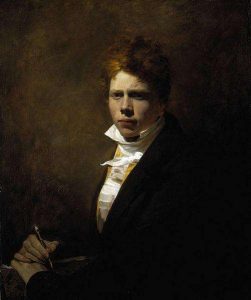
The family roots belonged to the Midlothian, Ratho Byres where they owned a small property for more than 4 centuries.
David Wilkie Artist
David was born an artist. He had this flair for art since a very tender age. David could draw even before he could read or write. In school, he would draw portraits of children and in exchange took colors, marbles, and paints.
In 1789, he was sent to Trustee’s Academy at Edinburgh, where he won a prize of ten pounds for drawing the “Diana and Callisto”.
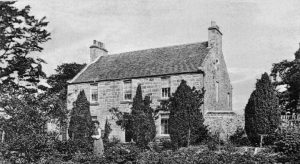
He then realized how he could make his living on the basis of art as a career. He continued the same, with great dedication.
He returned to his hometown in the year 1804 and started working on the “Pitlessie Fair” and a couple of other portraits and landscape paintings. This is how he made money to make his way to London.
David Wilkie’s Life in London
In 1805, David Wilkie arrived in London and stayed in lodgings and inns. Before leaving Scotland, he made “The Village Recruit”, which he sold in London. This and other works helped him make his living for about a year. He also started working at the Royal Academy.
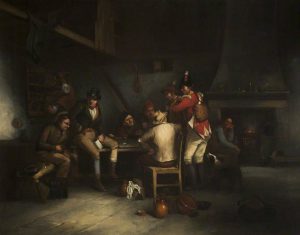
A relative of David Wilkie known as ‘Stoddart’ was a piano maker. He introduced Wilkie to Lord Mansfield. During this time, he completed his painting – The Village Politicians, which he showed Lord Mansfield.
David Wilkie Paintings
Lord Mansfield recognized the criticism the painting would go through and yet had it sold at the Academy. The painting was extraordinarily successful at the Academy and was later made a collection of Lord Mansfield himself who paid David Wilkie thirty guineas.
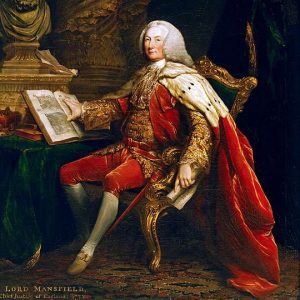
The success of “The Village Politicians” brought him fame and wealth. He received commissions from Lord Mulgrave and Sir George Beaumont.
David Wilkie Facts
Lord Mulgrave sent him a cheque of three times the agreed amount for his painting – The Blind Fiddler. “The Blind Fiddler” was sent for an exhibition in 1807.
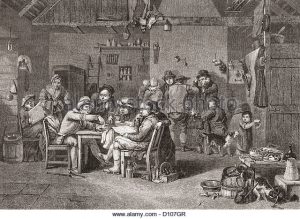
Another painting, called “The Rent Day” was sent for the same exhibition in 1809. After the death of Lord Mulgrave, it was sold for 750 guineas at Christie’s. Later, it was sold for 2000 English pounds.
He also came up with beautiful works such as the “Card Players” and “A sick Lady which did very well in the market and were sold for over 500 guineas.
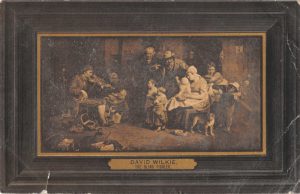
“A Sick Lady” went into the collection of Lord Lansdowne. David Wilkie then became elected as an associate member of the society.
Criticism Faced By David Wilkie
In the year 1810, David Wilkie faced some hardships after painting the most intricate an beautiful works of all, “The Man with the Girl’s Cap”.
He was challenged by the works of Edward Bird, an English Painter who worked in Bristol. He was also abolished from the committee of the Academy for a while.
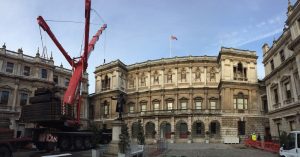
This led him to exhibit a separate show of his works in the summer of 1811. He held another exhibition of his works at the Pall Mall in 1812 which turned out to be financially unsuccessful.
However, in February 1812, he was elected to be become a full Academician at the Royal Academy of Arts by succeeding Sir. F. Bourgeois. In 1814, he was off to the Netherlands where he was arrested for sketching the famous gate.
Notable Works of David Wilkie
After becoming an Academician, he went to working and painted “The Village Festival”, “Blindmans Buff” and “Duncan Gray”.
He took a trip to Paris in 1814, along with his co-worker Robert Haydon who had a good time as noted in his diary.
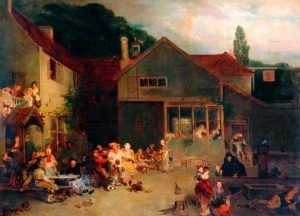
After their return, Wilkie went back to working on his “Distraining for Rent”. This piece of art was bought by the Directors of the British Institution.
In 1817, he was in Scotland where he covered all the places as any tourist would. He received an opportunity to paint the “Scott family” in the guise of peasants.
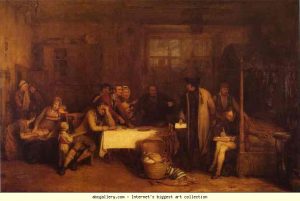
At this phase, he started painting for the Kings and Noble Lords, some of which were the “Penny Wedding” for the Prince Regent, “The Reading of the Will” for the King of Bavaria and “The Chelsea Pensioners and the Waterloo Gazette” for the Duke of Wellington.
Because of making these constant visits to Scotland every now and then, his health started deteriorating. This led to a massive change in his art.
In 1812, Wilkie lost his father which made him start living with his mother Isabella and sister Helen. They lived in Phillimore Place, Kensington. In 1824, he lost his mother too and this loss was a huge cause of his illness.
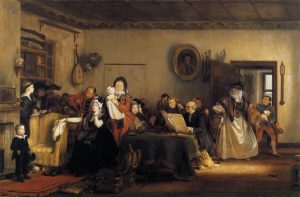
He traveled all across Europe covering Paris, Milan, Pisa, Genoa, Florence, Naples, Rome, Bologna, Parma, Venice, Innsbruck (Western Austria), Munich, Prague, Vienna. From Italy, he went to Spain, where a crowd of unknown Spaniards changed his art form.
He lived in Spain for a while and sent pictures to the Royal Academy. He returned back to England in 1828.
After this, he became carefree and open with his paintings, giving less attention to detail. During this time, he painted the “Napolean and Pius VII” and “The Queen’s First Council”.

In 1830, Sir Thomas Lawrence, a British Painter and the fourth president of the Royal Academy passed away.
Therefore, David Wilkie filled in his position of Painter in Ordinary to the King and was also brought forward to the post of Presidency at the Academy. However, he didn’t receive enough votes to make it to the post.
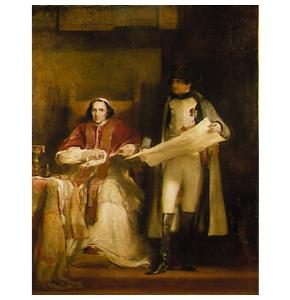
He painted many pictures during this time, namely “The First Earning” that belongs in the Royal Gallery today. He took another tour which became his last one.
Death of David Wilkie
David left London in August 1840, along with William Woodburne he made his way to Constantinople, where he painted the Sultan’s portrait after which he went to explore Jerusalem.
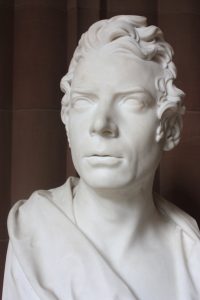
On his way home, by route of Alexandria, he had a sudden illness and passed away on 1st June 1841. He died at Gibraltar and was buried the same day at the sea.
More Info On- John Philip, William Powell, Frederick Richard Pickersgill